Tucked away amongst the jagged peaks of Montserrat, the Benedictine Monastery of Santa Maria de Montserrat is one of the most popular day trips from Barcelona.
The monastery dates back to the eleventh century and was built to house a wooden statue of Our Lady of Montserrat, which, legend has it, was found in a cave on the mountainside. It is also home to the famous Escolania de Montserrat boys’ choir, which performs twice daily except Saturdays.
Even if you’re not religious and aren’t interested in visiting the monastery, the mountain itself is totally unique, and it’s worth visiting Montserrat for the views alone.
This post covers everything you need to know when planning your trip to Montserrat. There’s information about what to see and do, as well as transport, tickets, tours, places to eat, and where to stay. Plus, I’ve included three walking routes, two tried-and-tested itineraries and lots of helpful tips.
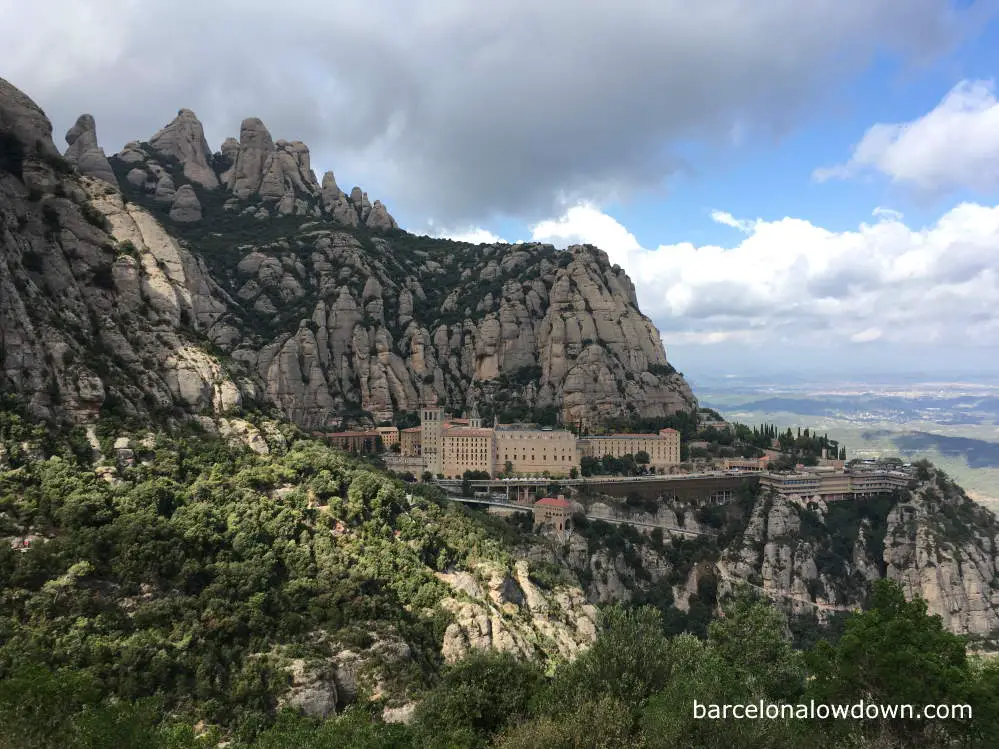
Montserrat Guide 2024
A Brief History of Montserrat
The history of the Montserrat mountain range began around forty-five million years ago when the area was under water at the mouth of the River Llobregat.
Boulders and silt carried by the river were slowly deposited to form a large fan of sedimentary rock until, twenty-five million years ago, the movement of tectonic plates caused the land to rise up and the sea to recede.
In the years that followed, wind and rain slowly eroded the softer rock, leaving behind the jagged mountain of Montserrat, which, with an altitude of 1,236 metres, dominates the surrounding area.
The region was settled during the fifth century BC, and it’s believed that Montserrat has been a place of worship since the second century AD when a temple dedicated to the Roman goddess Venus was built here.
Then, in 880 AD, a group of young shepherd boys found a wooden statue of the Madonna and child in a cave on the side of the mountain. According to the legend, the ancient statue was carved by Saint Luke, and the shepherds were drawn to the cave by a celestial light.
Initially, plans were to move the statue to nearby Manresa, but it became so heavy that it couldn’t be moved, so the local clergy decided to build a chapel around it.
In the year 888 AD, Wilfred the Hairy donated the nearby Hermitage of Santa Maria to the Monastery of Ripoll.
In 1025, the hermitage was transformed into a monastery and began receiving pilgrims who were drawn by stories of miracles performed by the statue, which had become known as Our Lady of Montserrat.
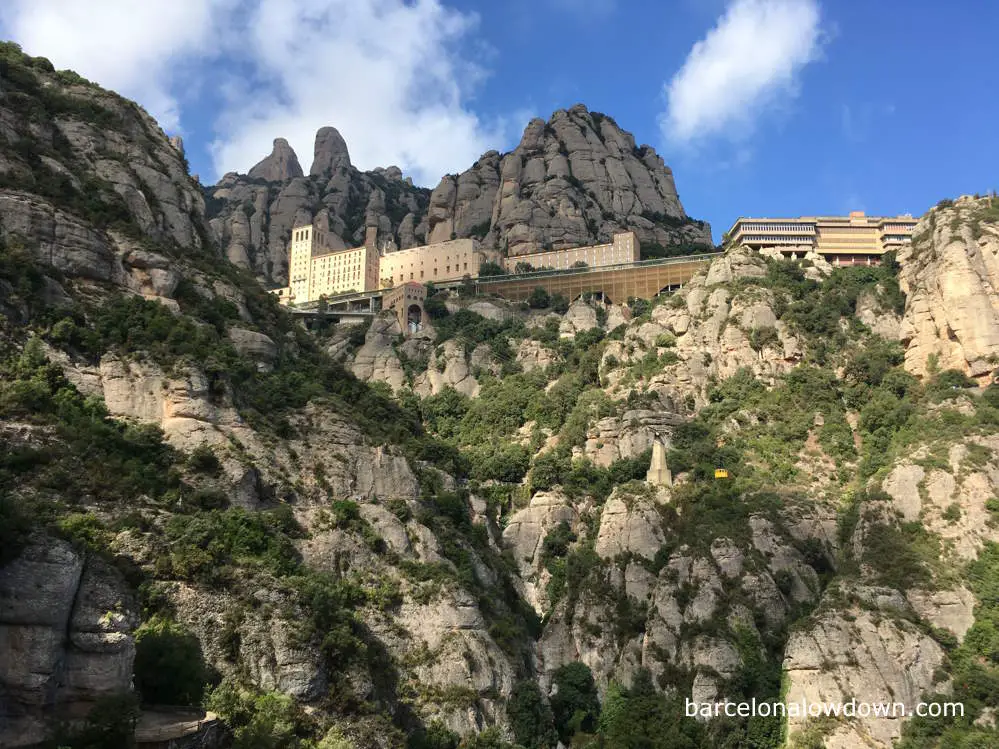
During the sixteenth century, a new basilica was built to house the Madonna statue, which was moved there from La Santa Cova.
Between the fifteenth and eighteenth centuries, Montserrat became an important religious centre visited by pilgrims from throughout Europe.
The monastery was all but destroyed by Napoleon’s troops during the Peninsular War of 1807 to 1814. Then, in 1835, the abbey’s properties and treasures were confiscated during the Ecclesiastical Confiscations.
The monastery was restored in 1844, and in 1881, Pope Leo XIII declared Our Lady of Montserrat the patron saint of Catalonia.
The monastery was abandoned again during the Spanish Civil War, although this time, the Catalan government was able to protect the buildings.
The Black Madonna was reinstated again in 1947, and since then, the buildings have been restored and extended to accommodate the large number of pilgrims and tourists who visit each year. [source]
What to see and do at Montserrat
The Santa Maria de Montserrat Monastery

The Santa Maria de Montserrat Monastery is a Benedictine abbey founded in the eleventh century by Abbot Oliba, although little remains of the original Romanesque buildings.
The current abbey, which is a mixture of Gothic and Renaissance architecture, dates back to the sixteenth century and was rebuilt during the nineteenth century. The main façades of both the abbey and the basilica were built during the twentieth century.
The abbey is home to around eighty monks and houses a library and a school. However, since it is an active monastery, many areas of the building are closed to the public. You can only visit the basilica, including the throne room of Our Lady of Montserrat, the atrium and the museum.
The Basilica is open daily from seven a.m. to eight p.m., although you can only access the statue of the Black Madonna from eight a.m. until twelve-thirty p.m. and from twelve thirty p.m. until six-thirty p.m.
Upon arrival at Montserrat, there is a flight of stairs which leads to the monastery directly in front of the rack railway station, between the bank and the souvenir shop. Alternatively, you can follow the road to the left (normally closed to vehicles), which also leads to the monastery.
It only takes a few minutes to walk from the train station to the plaza in front of the monastery, where you will typically see a line of pilgrims queueing up in front of the arch at the right-hand side of the building. This is the queue to visit the Black Madonna statue; if you only want to enter the basilica and the atrium, you can enter directly via one of the other arches where there aren’t usually queues.
The statue of Our Lady of Montserrat is located above the altar in the apse of the basilica. If you aren’t interested in getting up close, you can also see the statue from the nave.
Entry to the basilica costs €7 and is included in the Trans Montserrat and Tot Montserrat visitor passes described below.
Our Lady of Montserrat
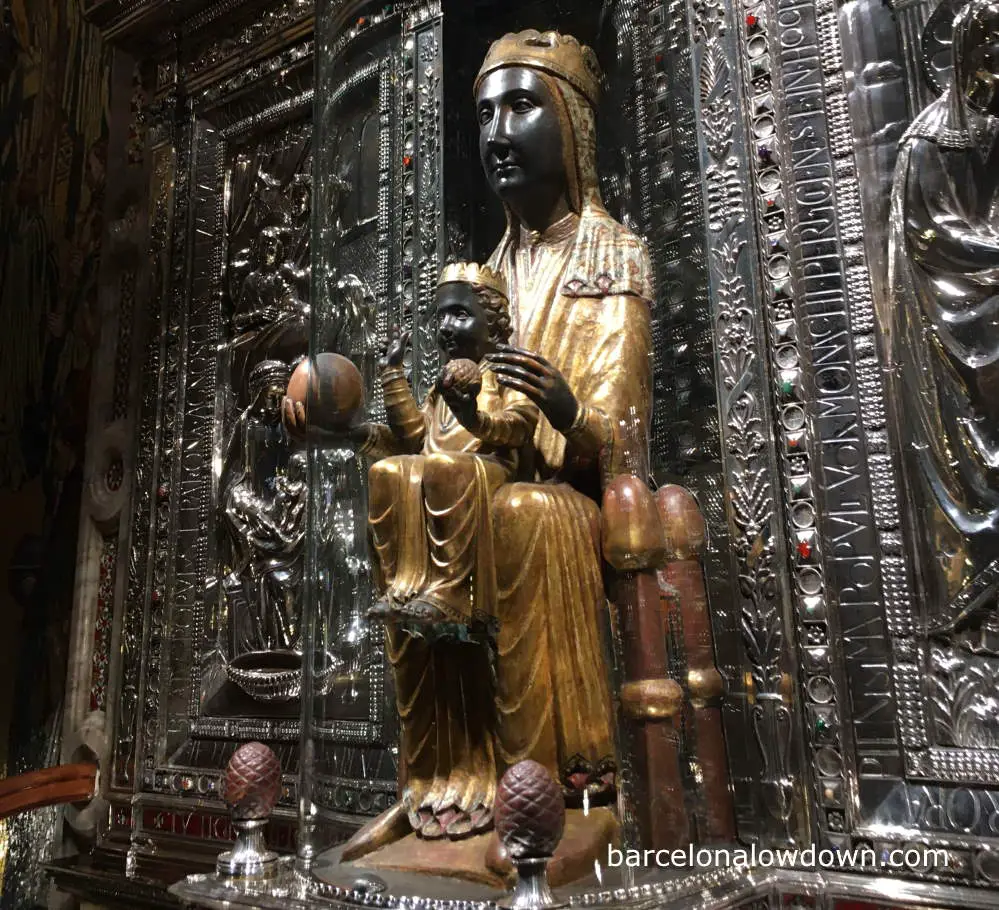
Our Lady of Montserrat is a ninety-five-centimetre polychrome statue of the Madonna and child, which sits in a guided throne room behind the altar of the Basilica de Santa Maria de Montserrat. The Romanesque-style statue was carved in the twelfth century and is one of the few Black Madonna statues in Europe.
To get to the statue, you enter the monastery via the arch at the right-hand side of the building. The entrance is easy to spot because unless you arrive early, there’s usually a line of pilgrims queuing up.
After entering the monastery, you pass through a series of chapels before coming to a flight of stairs leading up to the opulent throne room where the statue sits.
When visiting the Black Madonna, pilgrims traditionally touch or kiss the orb, which protrudes through the glass screen that protects the rest of the statue.
After leaving the throne room, you pass through a small chapel before coming to a passageway called the Ave Maria path, where you can light a candle in homage to Our Lady of Montserrat.
Tickets to see Our Lady of Montserrat cost €10, which includes entrance to the basilica and is included in the Trans Montserrat and Tot Montserrat visitor passes described below.
The Escolania de Montserrat boys’ choir
Another reason to visit the basilica is to hear the world-famous Escolania boys’ choir, which dates back to the fourteenth century and is one of the oldest choirs in Europe.
The choir performs daily, except Saturdays, and you can reserve a place in advance here. Tickets cost €10, and availability is limited. If no places are available on the day you want to visit, it’s worth checking to see if there are any spaces left on this Montserrat tour, which includes seeing the choir.
| Day | Performances* |
| Monday | 13:00 and 19:10 |
| Tuesday | 13:00 and 19:10 |
| Wednesday | 13:00 and 19:10 |
| Thursday | 13:00 and 19:10 |
| Friday | 13:00 |
| Saturday | none |
| Sunday | 11:00 and 18:45 |
*The timetable may vary due to religious celebrations and school holidays.
If you plan to see the boys’ choir, the 10:36 train from Plaça d’Espanya will usually get you to Montserrat in time to see the choir perform at 13:00. However, I recommend getting there sooner if possible.
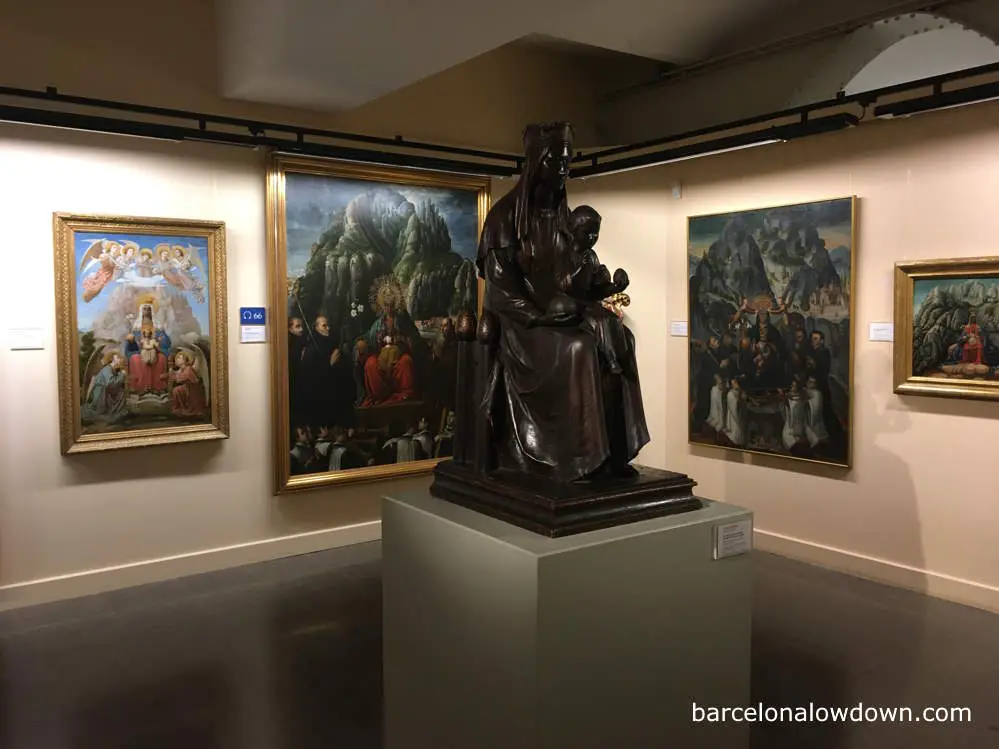
The Montserrat Museum
The Abbey also houses an extensive art museum with more than a thousand exhibits, most of which were either collected by the monks or donated to the monastery.
In addition to paintings, there is also a section dedicated to the Black Madonna and a collection of archaeological exhibits from the middle east, including a three-thousand-year-old sarcophagus from Ancient Egypt.
You should allow about an hour to visit the museum, which is open daily from ten am until four pm. Entry to the museum currently costs €8 and is included in the Tot Montserrat pass.
There’s more information on the museum’s website.

L’Espaí Audiovisual exhibition
The Espai Audiovisual exhibition combines an audio guide with a couple of short films and a series of displays to give you an overview of the history and geology of the mountain, the history of the Abbey, life in the Abbey today and the boy’s choir. There is also a section dedicated to Our Lady of Montserrat.
You should allow about half an hour to visit the Espai Audiovisual, which is open from Monday to Friday from nine a.m. to six p.m. and at the weekends until 6:45 p.m. Entry to the museum currently costs €5.50 and is included in the Trans Montserrat pass.
La Santa Cova

The Santa Cova, or Holy Grotto, is where everything started. According to legend, one Saturday afternoon in 880, a group of shepherd boys who were tending their flocks on the foothills of Montserrat were drawn by a celestial light emanating from a cave. The same thing happened the next two weekends when the shepherd boys returned, first with their parents and then with the clergy from Olesa de Montserrat.
Upon further investigation, a group of monks found a statue of the Madonna, which Saint Luke had carved way back in the earliest days of the Christian faith. When they tried to move the figure, it grew incredibly heavy, so in the end, they decided to leave it in the cave and build a church around it.
Whether or not the story is true, the chapel of the Santa Cova was built between 1696 and 1705. Inside the chapel, there’s a small altar set into the bare rock with a replica of the Our Lady of Montserrat statue. Inside, the chapel is dark, austere and quite atmospheric.
When the chapel was built, a path was cut into the rock to facilitate access to the chapel. The route is lined with a series of carvings created at the beginning of the twentieth century by famous artists of the time, including Antoni Gaudí, Josep Llimona and Josep Puig I Cadafalch.
To get to the grotto, you can either walk down or take the funicular, which runs from in front of the monastery to the start of the path, or you can walk. The route down to the Santa Cova is steep, so you might want to walk down and take the funicular back up.
You should allow about an hour to visit the Santa Cova, which is open daily from 10:30 a.m. to 4:00 p.m.
St. Michael’s Cross
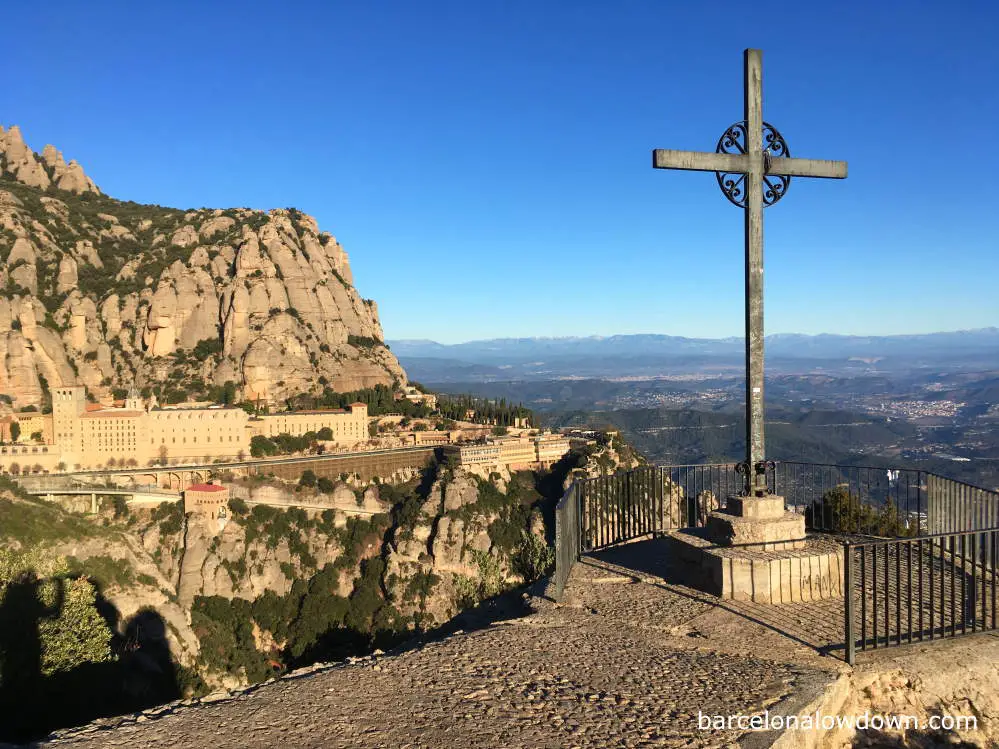
In the Middle Ages, before the construction of the road, the cable car and the funicular, pilgrims used to reach the basilica by following a path from the nearby town of Collbató.
St. Michael’s Cross marks where the pilgrims got their first view of the monastery. To this day, the lookout point where the cross stands commands some of the best views on Montserrat. On a clear day, you can see as far as the Pyrenees mountain range.
The path to St. Michael’s cross starts beside the lower station of the Sant Joan funicular and, although uphill, is very easygoing. It takes approximately fifteen minutes to walk to St. Michael’s Cross and is much less steep than the path to the Santa Cova.
The Stairway to Heaven monument
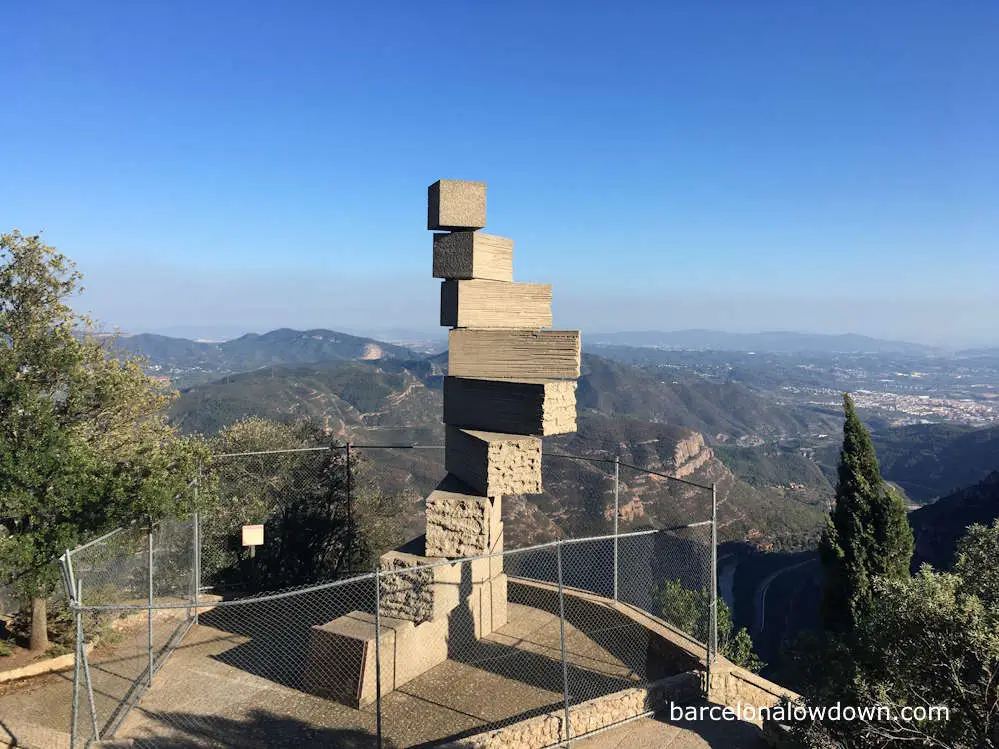
The Stairway to Heaven monument is really called Stairway of Understanding (Catalan: L’Escala de l’Enteniment) and is dedicated to the thirteenth-century philosopher, poet and mystic Ramon Llull, who developed a system to discover the truth by organising everything into eight groups.
The monument was created in 1979 by Josep Maria Subirachs, who placed eight large stone slabs, one on top of the other, in reference to Llull’s theory.
Impressive as it is, the moment went largely unnoticed until the advent of social media, when people started posting photos of themselves standing on the top step. Unfortunately, things got so out of hand that the monument has now been fenced off to prevent people from climbing on it.
The Stairway to Heaven monument is located behind the self-service restaurant near the coach park, five minutes from the monastery.
The Aula Natural exhibition and viewpoint
Located right on top of the upper station of the Sant Joan funicular, the “Aula Natural” is basically a small room with a few screens and displays dedicated to the flora and fauna of Montserrat.
There is also a small terrace with views of the mountains and large windows where, if it’s cold outside, you can sit on wooden benches and enjoy the view.
There are also a few vending machines here selling drinks and snacks and public toilets on the ground floor.
The Monastery of Santa Cecília

In addition to the Monastery of Santa Maria de Montserrat, there are two other monasteries on Montserrat mountain. The earliest of them is the Monastery of Santa Cecília, a small Romanesque-style building dating back to the tenth century.
The building functioned as a monastery until 1954 when it was deconsecrated and used as a hostel for walkers. It is currently used as an art gallery with an exhibition by American artist Phil Scully. More information here.
The monastery is approximately three and a half kilometres from the Monastery of Santa Maria de Montserrat. If you have a car, there is a car park that opens when the exhibition is open. When it isn’t open, you can park in the lay by at the entrance to the car park.
You can walk to Santa Cecilia by following this trail on Wikiloc. The route starts by following the Camí del Degotalls for about twenty minutes before descending to follow a path alongside the BP-1103 for about half an hour until you reach the monastery.
Hiking on Montserrat
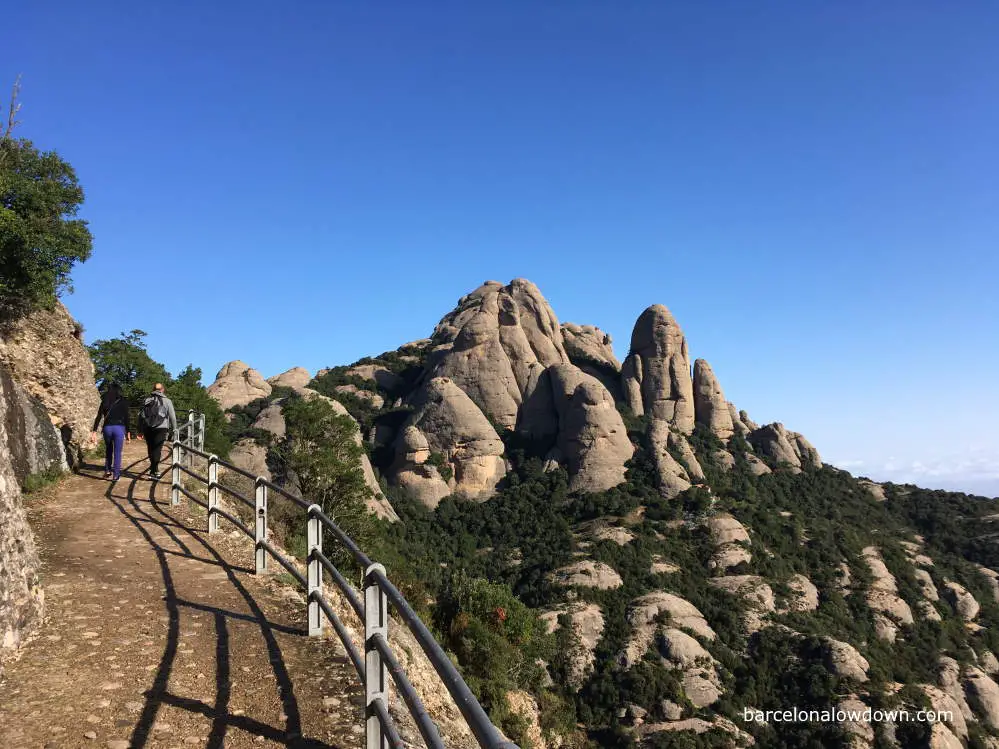
Apart from the spiritual and cultural aspects of Montserrat, the views from the mountain are absolutely breathtaking, and even if you are primarily interested in seeing the monastery, I encourage you to at least take the Sant Joan Funicular up to the top of the mountain and see the view from the viewpoint.
If you plan to do some walking, I recommend you visit the Tourist Information office, which is next to the rack railway station, in front of the monastery. They have several free leaflets with suggested walking routes, and the staff can help you decide which would suit you best based on the time you have available, your experience and your physical condition. All of the routes are signposted, and the paths are well-maintained, so you don’t need to worry about getting lost.
Although I can’t claim to have walked all the paths on Montserrat, here are a few of my favourites:
1. From Montserrat Monastery to St. Michaels Cross & return (Easy)
This easy walk is just over two kilometres long and takes about half an hour. Although there is a slight uphill gradient on the way towards the cross, the footpath is paved and is suitable for walkers of all ages.
The walk starts next to the bottom station of the Sant Joan funicular and is signposted. To get to St. Michael’s cross, you follow the path past the campsite towards the Ermita de Sant Miquel (St. Michael’s hermitage). Shortly before you arrive at the hermitage, you’ll see a path off to the left (also signposted) leading to St. Michael’s cross.
Once you’ve enjoyed the views and taken a few photos, you simply retrace your steps back to the monastery. There’s no way you can get lost on this walk, but I’ve created a Wikiloc trail just in case.
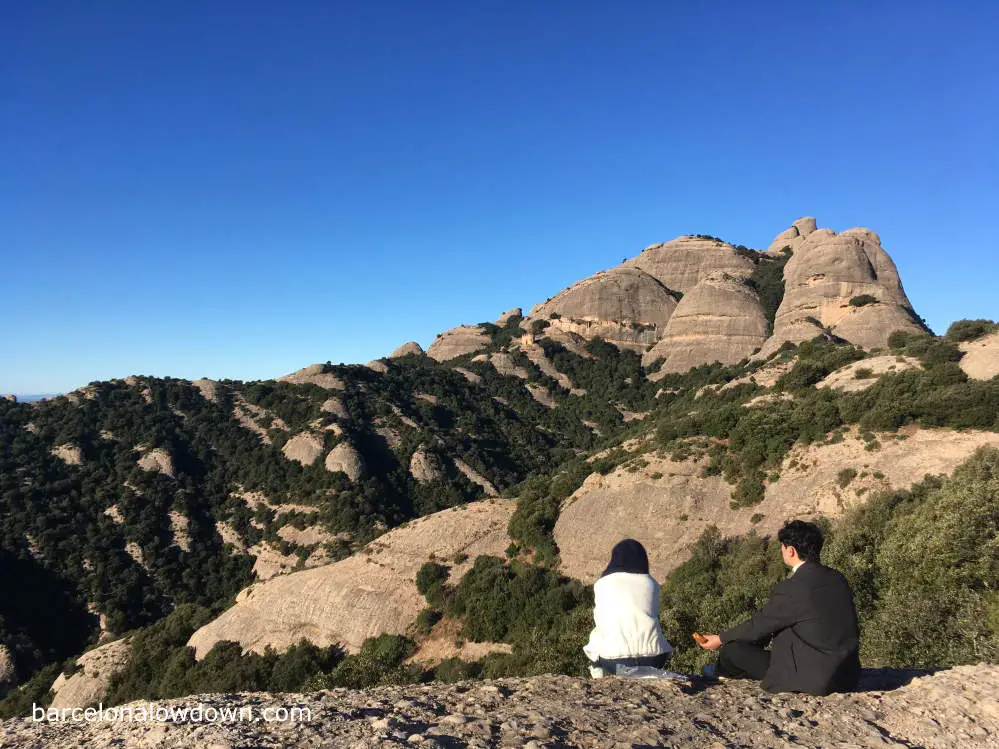
2. From the Pla de les Taràntules to the Monastery of Montserrat via St Michael’s cross (Easy)
This easy walk starts from the top station of the Sant Joan Funicular and is approximately three kilometres long and takes about forty-five minutes. At the start of the walk, there’s a short uphill section; if it looks like it would be too demanding, you can always check out the views from the viewpoint and then take the funicular back down.
Turn left as you leave the funicular station and follow the path uphill for about five minutes. Shortly after you start walking, you should see a sign indicating that you are on the correct trail.
From here onwards, the path continues downhill past St Michael’s Cross and back to the monastery. Once again, the views of the monastery are fantastic, and you shouldn’t get lost, but I’ve created another Wiciloc trail to make sure.
3. From the Pla de les Taràntules to St. Jerome’s Peak and back down to the Monastery (Moderate)
At an altitude of 1,237 metres above sea level, Sant Jerome’s Peak (Catalan: Sant Jeroni) is the highest point on Montserrat and offers visitors breathtaking panoramic views. On a clear day, you can see the church on top of Mt. Tibidabo (Barcelona) and out to sea as far as the Balearic Islands. Turning inland, you can see the Pyrenees mountains.
With the promise of such spectacular vistas, it will come as no surprise to learn that the hike up to Sant Jeroni is one of the most popular walks on the mountain.
There are two main routes up to Sant Jeroni. The first route is the so-called “stairs of the poor”, a stone stairway carved into the rock that starts near the monastery. The other, easier route is to take the Sant Joan Funicular up to Pla de les Taràntules and then continue upwards following the so-called “new path”.
I recommend you take the second option and then either walk back down following the “stairs of the poor” or retrace your steps back to the funicular.
The advantage of taking the funicular is that it avoids a 300m ascent up something like a thousand stone stairs. Believe me; your knees will thank me!
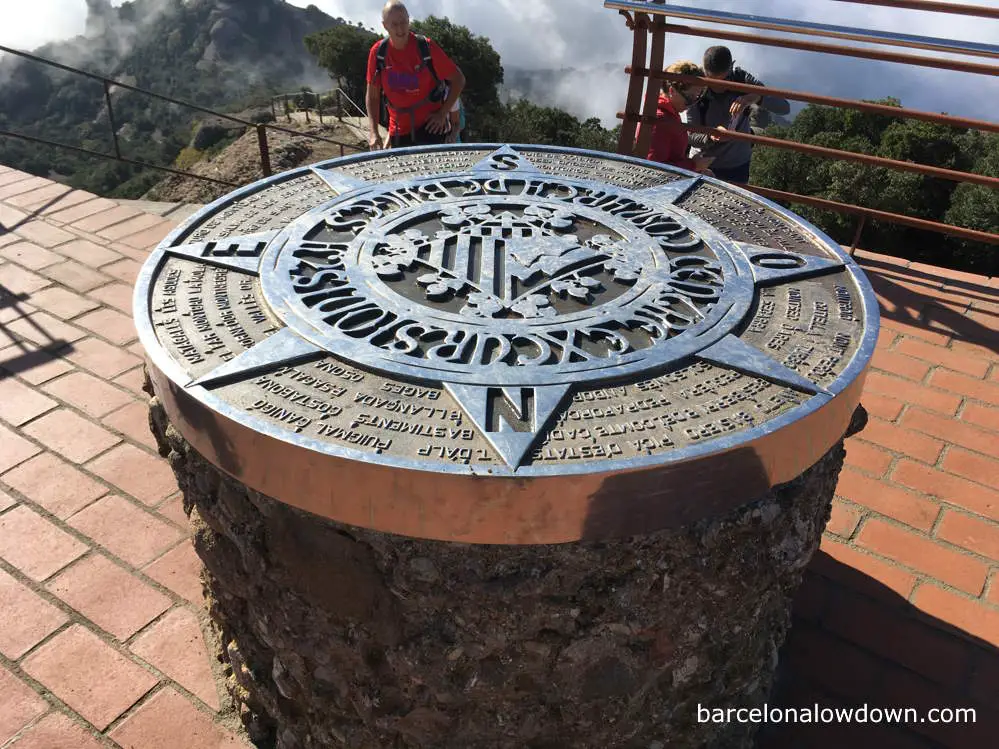
Assuming that you take the funicular, the route takes about three hours to complete, and I would classify it as an easy to moderate hike. The only reason I don’t classify it as easy is the final ascent up to the lookout point at the summit, which is up a steep flight of stairs.
As you leave the funicular, follow the path leading round to the right. After a few metres, you’ll be on the concrete path with a handrail shown in the photo labelled “On route to St. Jerome’s Peak from the Sant Joan funicular” above. There are good views here of some of Montserrat’s typically jagged rock formations.
Basically, you just need to follow this path to the Sant Joan Hermitage. There are several viewpoints and a few metal signs to guide you along the way.
Shortly before you reach the hermitage, another path joins the trail from the right. This is the route up via the “stairs of the poor” and “Pla dels Ocells”, which we will be taking on the way down.
Turn left in front of the hermitage and then follow the footpath up towards the top of the mountain, which still isn’t visible yet.
Finally, you reach the final ascent up a relatively narrow set of concrete steps to the peak. There are about a hundred stairs in all (disclaimer: I haven’t counted), and there’s a metal handrail.
When you arrive at the peak, the views are spectacular, and if you have time and are reasonably fit, I would encourage you to do this hike. The only part of the walk which is a bit demanding is the final stretch up to the peak, so if you get there and find you don’t like the look of it, you can always skip it and complete the walk.
From here, you retrace your steps back past the hermitage until you come to a sign indicating “Pla dels Ocells” which is the route back down to the monastery via the stairs of the poor.
As you begin the descent, you pass through an area of woodland before coming to an open valley with good views. Finally, you return to the monastery down the stairs of the poor, where you’ll typically meet a line of sweaty, out-of-breath hikers on their way up.
You can see the Wikiloc trail of the route here, which includes plenty of photos.
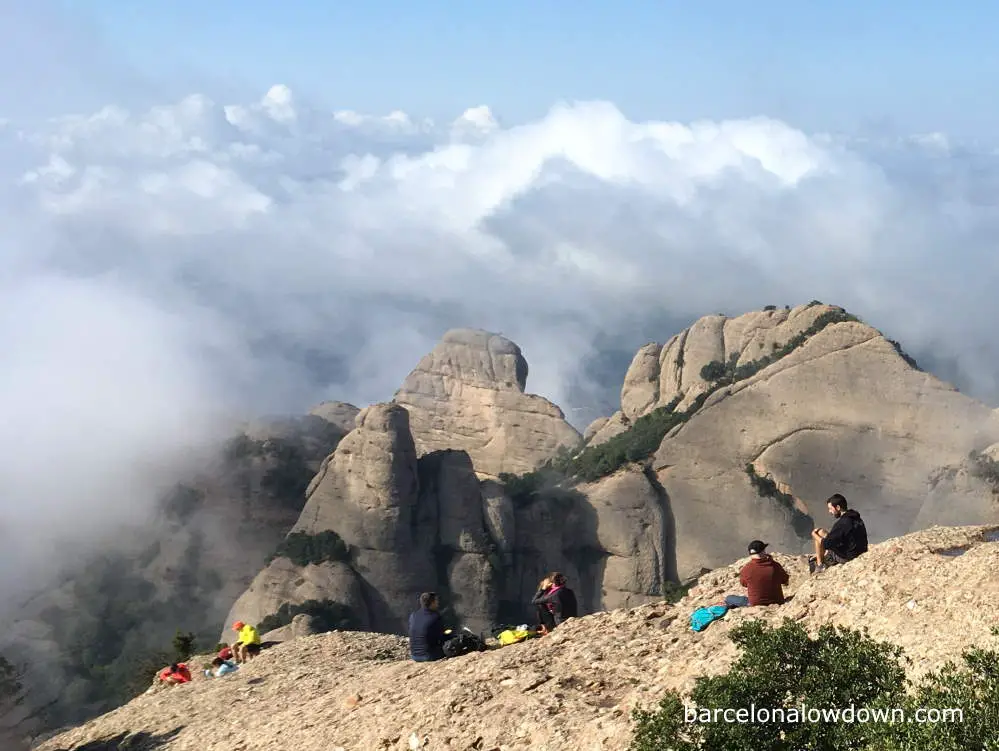
Transport on Montserrat
Once you arrive at the foothills of Montserrat (more information below), several modes of transport are available to get you up to the monastery and then take you further up the mountain.
Tickets for the funiculars, rack railway and cable car can be purchased from the ticket booths or ticket machines at the stations at Montserrat. However, if you will be travelling to Montserrat by train, it usually makes sense to purchase a combined ticket.
Montserrat cable car
The Montserrat cable car (Catalan: Aeri de Montserrat) was inaugurated in 1930 and is the most spectacular way of getting to the monastery. The cable car takes five minutes to travel from the Aeri de Montserrat train station to the monastery and departs every fifteen minutes or so from 9:30 to 18:15.
The advantages of choosing the cable car are the views and the fact that it’s a fun way to travel. The only downside is that the gondola can only accommodate 35 people at a time, standing room only, and at peak times, you may have to wait in line, although you seldom have to wait long.
| Ticket type | One-way | Return |
| Adult | €8.95 | €14.00 |
| Child (4 to 13 years) | €4.70 | €6.75 |
| Infant (under 4) | Free | Free |
| Seniors (over 65) | €7.80 | €11.20 |
Book tickets for the Montserrat cable car online >>
The cable car hasn’t been adapted for wheelchair access. If you, or anyone in your party, has difficulty climbing stairs or uses a wheelchair, you should take the rack railway.

Monserrat rack railway
The rack railway may not have the wow effect of the cable car, but the view from the modern carriages is still pretty impressive.
The timetable varies throughout the year, but as a rough guide, there are departures every twenty minutes from 8:35 to 19:35 during the high season and every hour from 08:35 to 18:35 at all other times. Full timetables here.
| Ticket type | One-way | Return |
| Adult | €8.40 | €14.00 |
| Child (4 to 13 years) | €4.20 | €7.00 |
| Infant (under 4) | Free | Free |
| Seniors (over 65) | €7.55 | €12.60 |
The rack railway is accessible to wheelchairs and takes fifteen minutes to complete the journey from Monistrol de Montserrat to the monastery.
The rack railway stops at three stations: Monistrol de Montserrat (the train station), Monistrol-Vila (where the coach and car park are located), and Montserrat Monastery.
When returning from the monastery, some trains only go as far as Montserrat-Vila. If, when returning to the train station, you mistakenly catch a rack railway train which only goes as far as Monistrol-Vila, you should remain on the platform and wait for the next train.
Walking from Monistrol Vila to Monistrol de Montserrat train station takes about ten minutes. However, since you already validated your ticket when you boarded the rack railway, the automatic ticket barriers won’t let you enter the train station. Fortunately, there will normally be a member of staff on hand, and, in my experience, if you show them your ticket, they will let you through the barriers.
The Sant Joan Funicular
The first of two funicular railways, the Funicular de Sant Joan, runs from near the monastery to the Pla de les Taràntules, near the top of the mountain, which is the starting point for several popular hikes.
The funicular departs every fifteen minutes from 10:00 to 18:00 during the high season and from 10:00 to 17:00 at all other times.
| Ticket type | One-way | Return |
| Adult | €10.70 | €16.50 |
| Child (4 to 13 years) | €5.35 | €8.25 |
| Infant (under 4) | Free | Free |
| Senior (over 65) | €9.65 | €14.85 |
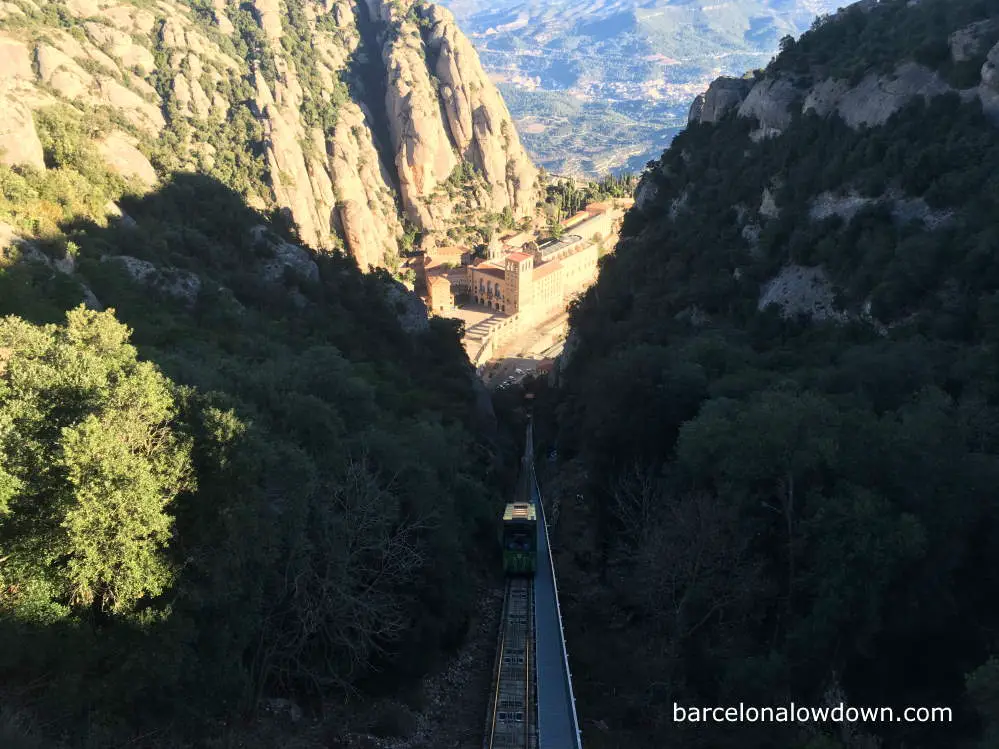
La Santa Cova Funicular
As its name suggests, the funicular de la Santa Cova takes you from near the monastery to the footpath leading to the Santa Cova.
The funicular departs every twenty minutes from 10:00 to 17:30 during the high season and from 10:00 to 16:30 at all other times.
| Ticket type | One-way | Return |
| Adult | €4.10 | €6.30 |
| Child (4 to 13 years) | €2.05 | €3.15 |
| Infant (under 4) | Free | Free |
| Senior (over 65) | €3.65 | €5.65 |
Both funiculars have glass roofs and offer panoramic views of the mountain and surrounding area.
Annual maintenance and inspections
The funicular railways and cable cars undergo regular safety inspections and maintenance, which typically take place during January or February.
When visiting during the winter, you should check the official websites (here and here) for more information. Alternatively, leave a comment below with your planned dates, and I’ll get back to you as soon as possible.

How to travel from Barcelona to Montserrat
The monastery can be reached by car, bike, public transport, and on foot. There is also a wide range of tours available which will take you from Barcelona to Montserrat.
Barcelona to Montserrat by train
The most convenient way of visiting Montserrat from Barcelona is by taking the train from Plaça d’Espanya to the foot of the mountain, followed by either the cable car or the rack railway up to the monastery. Either option is easy to organise by yourself with a minimum of forward planning.
Trains are operated by “Ferrocarrils de la Generalitat de Catalunya”, the Catalan government’s railway company, or FGC for short. Line R5 runs from Barcelona to Manresa, and there are two stations at the base of Montserrat: Montserrat Aeri and Monistrol de Montserrat.
Assuming your hotel isn’t near Plaça d’Espanya, you will start your journey by catching the metro, lines L1 or L3 to Espanya. Upon alighting the metro, you’ll see arrows above the platform with the FGC logo and arrows directing you to the FGC train station, which is connected to the metro station by a shared concourse.
As you continue along the corridors, there are more signs with the FGC logo and the words “A To Montserrat” and arrows pointing the way. Shortly after you go through the barriers to leave the metro, you’ll see large signs advertising the journey to Montserrat and yellow ticket vending machines.
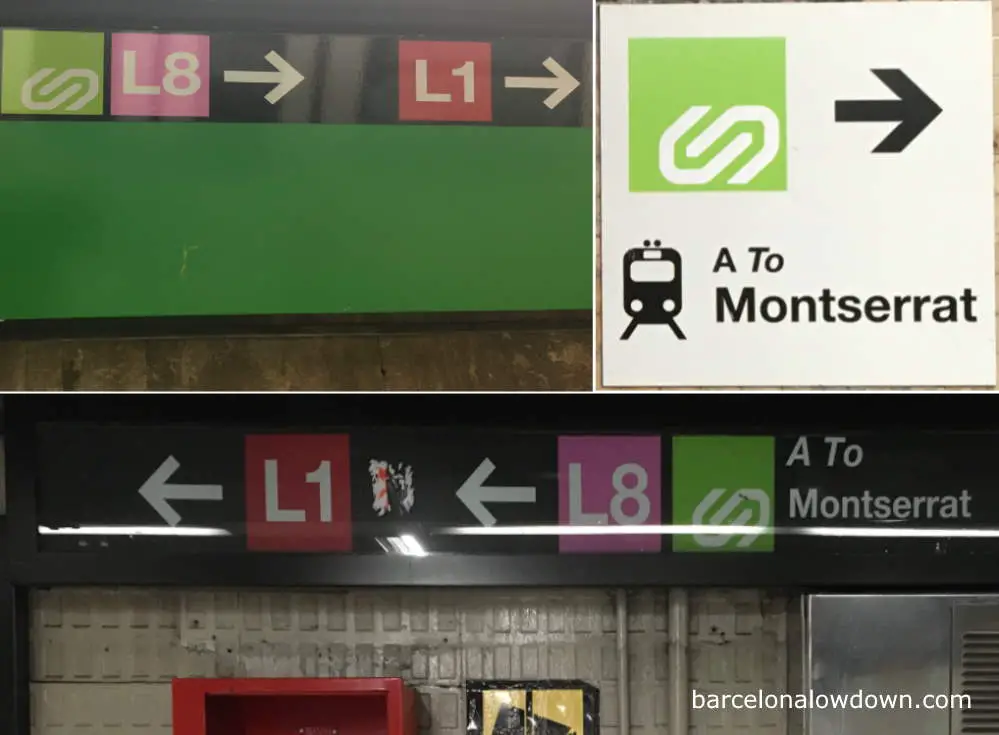
By default, the ticket machines are in Catalan, but there’s a flag icon near the bottom of the screen, which you can use to select your language.
Next, you should select the bright blue “Montserrat Combined Ticket” button, which will bring up a list of the different tickets that are available. I’ll go into more detail about the options and prices below, but in general, I recommend purchasing the Trans Montserrat pass, which includes a return ticket on the metro in Barcelona, a return train ticket to Montserrat, a return ticket for either the cable car or rack railway up to the monastery, unlimited travel on both funicular railways, plus entry to the basilica to see the Black Madonna statue.
When planning your trip, you should allow plenty of time to purchase your tickets at the machines at Plaça d’Espanya train station because there are often queues. This is especially true at the weekend.
After purchasing your tickets, you continue through the ticket barriers to the platforms. Immediately after the barriers, you will see screens showing the upcoming trains and which platform they will depart from.
To get to Montserrat, you need to catch the R5 line towards Manresa, which usually departs from either platform three or four. However, to be on the safe side, I encourage you to double-check the screens and the signs at either end of the train.
The train takes approximately one hour to travel from Barcelona to Montserrat. Initially, it runs underground before passing through several large industrial towns on the way to Montserrat.
For the best views, I recommend that you sit on the left-hand side of the train. After about forty minutes, you get your first view of Montserrat as the train passes through Martorell. There’s also an interesting medieval bridge here, which you can see from the train.
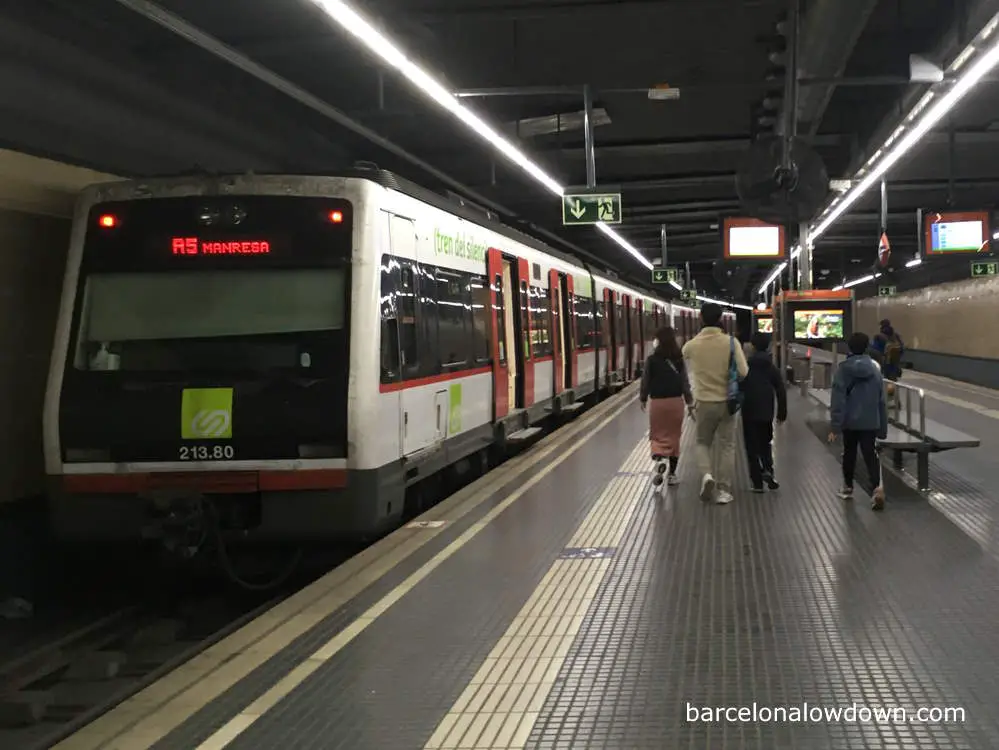
You don’t need to worry about missing the stop. Shortly before arrival at Aeri de Montserrat, there’s an announcement in English advising that you can alight here to catch the cable car to Montserrat. Likewise, shortly before you arrive at Monistrol de Montserrat, there’s an announcement telling you that you can change here for the rack railway.
For the cable car: Aeri de Montserrat is a very small station; as you alight the train, you’ll see the cable car station next to platform 1. Depending on what time you arrive, there may be a queue.
For the rack railway: There are four platforms at Monistrol de Montserrat station. The train from Barcelona arrives at platform one, and the rack railway to Montserrat departs from platform four. The rack railway is synchronised with the R5 trains arriving from Barcelona, and you seldom have to wait more than a few minutes here.
The journey from Plaça d’Espanya to the monastery, including either the cable car or the funicular, takes about ninety minutes. This doesn’t include the time taken to get from your hotel to the train station at Plaça Espanya.
| Ticket type | One-way | Return |
| Standard | €6.15 | €12.30 |
| Infant (under 4) | Free | Free |

Combined tickets for visiting Montserrat
When visiting Montserrat by train, there are several combined tickets which work out cheaper than purchasing individual tickets for the train, rack railway, cable car and funicular railways. They also save you time because you don’t have to stop and purchase tickets at each stage of the journey.
All of the tickets listed below can be purchased from the ticket booths and ticket machines at the FGC train station at Plaça d’Espanya, although if you decide to purchase the Trans Montserrat (recommended for most visitors) or the Tot Montserrat tickets, you should purchase them online because they include a return ticket by metro to and from Plaça d’Espanya.
Return train ticket plus cable car or rack railway
The most basic combined tickets include a ticket for the train from Barcelona to Montserrat plus a return ticket for either the cable car or the rack railway up to the monastery*.
The basic combined tickets are only available at the ticket machines and ticket booths at the FGC train station at Plaça d’Espanya and can’t be purchased online.
| Ticket type | One-way | Return |
| Adult | €14.55 | €26.30 |
| Child (4 to 14 years) | €10.35 | €19.30 |
| Infant (under 4) | Free | Free |
| Senior (over 65) | €13.70 | €24.90 |
| Ticket type | One-way |
| Standard | €15.10 |
*When purchasing any of the combined tickets, you have to decide upfront whether you want to take the cable car or the rack railway up to the monastery. If you want to combine both, for example, take the cable car up the mountain and then the rack railway back down, you have to purchase separate tickets.
Trans Montserrat
The Trans Montserrat ticket includes the following:
- Return trip on the Barcelona metro to Plaça d’Espanya
- Return transport by train from Barcelona to Montserrat.
- Return transport to the Montserrat Monastery by either cable car or rack railway*.
- Entry to the basilica and the throne room of Our Lady of Montserrat
- Unlimited travel on the Sant Joan funicular.
- Unlimited travel on the Santa Cova funicular.
- Entry to the Espai Audiovisual Exhibition.
| Ticket type | Price |
| General | €44.70 |
If you compare the price of a Trans Montserrat ticket with the prices above, you’ll see that it’s €25 cheaper than purchasing the tickets separately.
Buy Trans Montserrat tickets online >>
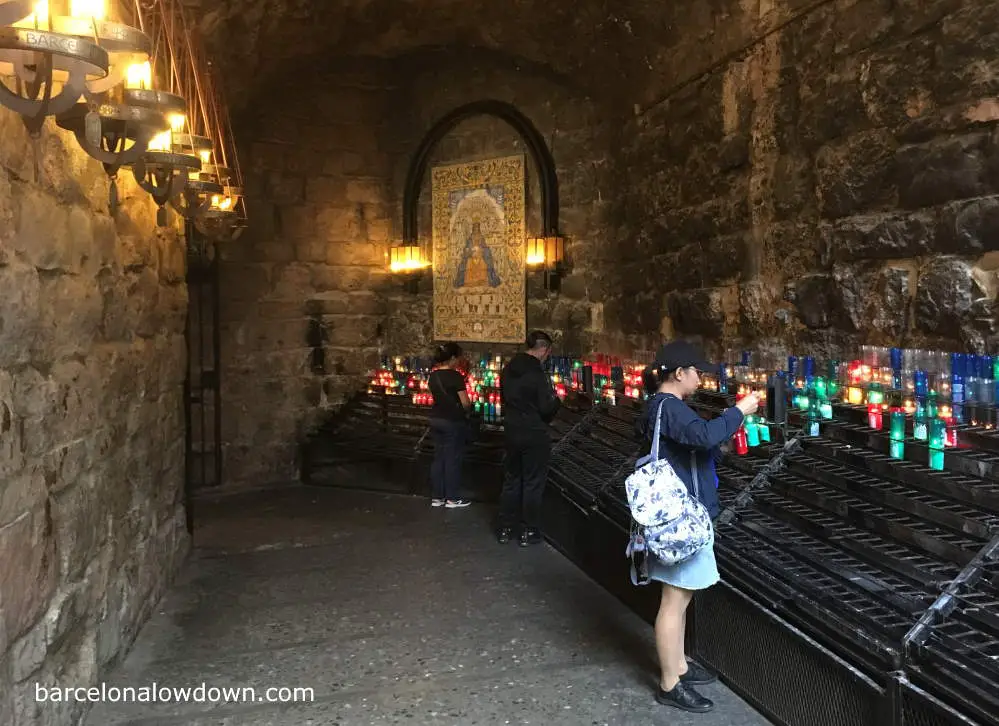
Tot Montserrat
The Tot Montserrat ticket includes the following:
- Return trip on the Barcelona metro to Plaça d’Espanya
- Return transport by train from Barcelona to Montserrat.
- Return transport to the Montserrat Monastery by either cable car or rack railway*.
- Entry to the basilica and the throne room of Our Lady of Montserrat
- Unlimited travel on the Sant Joan funicular.
- Unlimited travel on the Santa Cova funicular.
- Buffet lunch at the monastery.
- Entrance to the Montserrat Museum.
- Entry to the Espai Audiovisual Exhibition.
| Ticket type | Price |
| General | €68,25 |
As its name implies (tot mans all in Catalan), the Tot Montserrat covers just about everything you could possibly need when visiting Montserrat from Barcelona. If you plan to spend the day at Montserrat and eat at the buffet restaurant, then this ticket also offers very good value for money.
Buy Tot Montserrat tickets online >>
When purchasing the Trans Montserrat or Tot Montserrat ticket using the links above, you receive an email with a voucher allowing you to pick up your tickets from the following locations:
- The Tourist Information office at Plaça de Catalunya.
- The Tourist Information Points at Barcelona Airport.
- The FGC train station at Plaça d’Espany.
Barcelona to Montserrat by bus
The cheapest way to travel to the Monastery of Montserrat is by bus. At the time of writing, the adult fare is currently €5.10 each way.
Buses depart from Barcelona Sants Bus station, and the journey from Barcelona to the Montserrat Monastery takes one hour and twenty-five minutes. The buses drop you at the coach park, which is a five-minute walk from the monastery.
The only disadvantage is that there is only one bus per day in each direction, but if the timetable fits in with your plans, then the bus is a good low-cost option. Check timetables here.
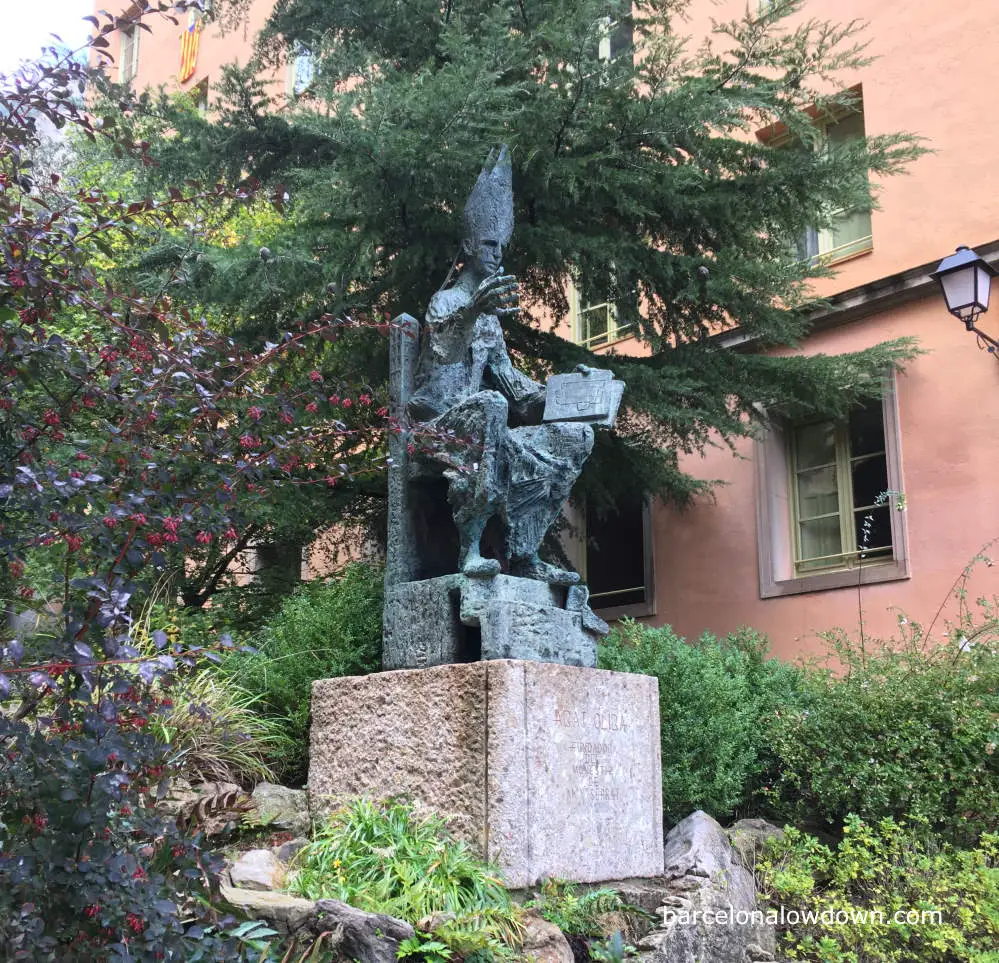
Barcelona to Montserrat by car
Firstly, I don’t recommend that you rent a car to visit Montserrat.
Having said that, if you do have a car, then you could drive to Montserrat in about an hour, depending on traffic. Most of the journey is fairly mundane, but as you approach the monastery, you get some good views of the mountain. Google maps will probably give you a couple of options, but I recommend taking the A-2 followed by the BP-1103, which gives you a pretty scenic lap of the mountain.
There’s a paid car park near the monastery, which, at the time of writing, is free for the first thirty minutes and then costs €7.00 per day.
The car park runs alongside the road; generally speaking, the later you arrive, the further you’ll have to walk to get to the monastery (typically between ten and fifteen minutes).
Before you arrive at the car park, you’ll probably see cars parked in laybys, but you don’t need to worry unless it’s a very busy weekend; there will usually be spaces available.
Alternatively, there are free car parks at the foot of the mountain, at the cable car station and at the rack railway station. So you could park there and catch either the cable car or the rack railway up to the monastery. Obviously, although the car parks are free, you will have to purchase tickets for the train or the cable car.
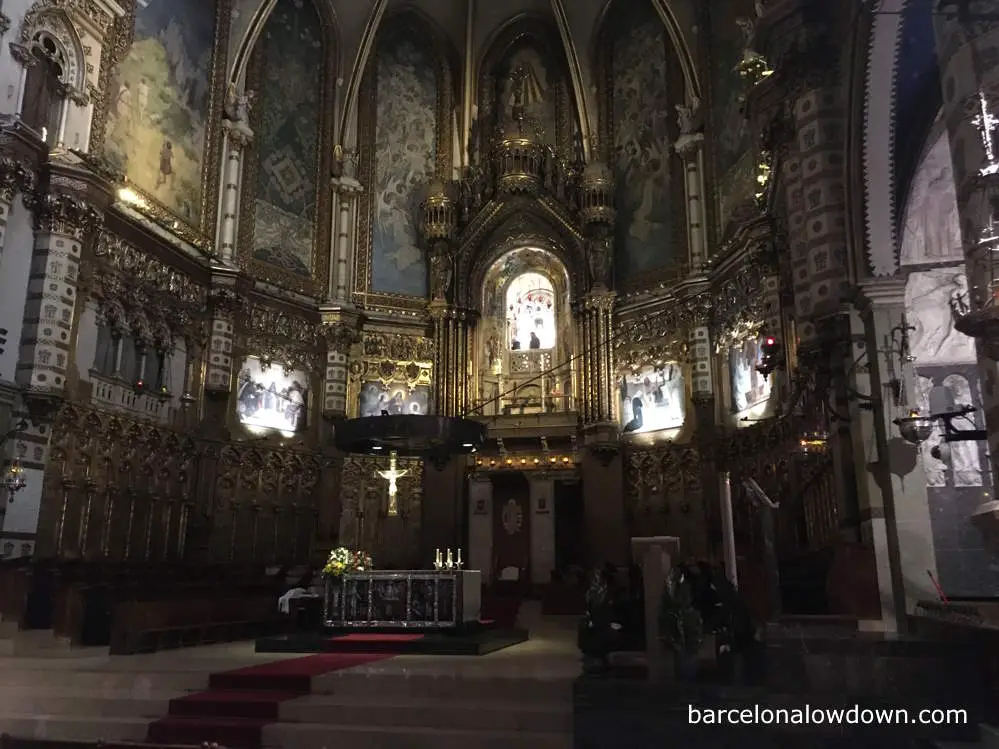
Tours to Montserrat from Barcelona
There is a wide range of tours available for visiting Montserrat, ranging from basic tours, which include little more than the transport to get there, to guided hiking tours and full-day tours, which combine Montserrat with another city or activity.
I’ve not taken a tour myself, so unfortunately, I haven’t got first-hand experience, but here are a few tours which sound like they would be good choices:
Montserrat Rack Railway and Train Round Trip
This inexpensive package includes return transport by train and the rack railway, an audioguide, entry to the monastery and the Montserrat museum, plus liqueur tasting.
Montserrat Half-Day Guided Tour
This half-day guided tour from Barcelona includes bus transport to and from Barcelona to the foot of the mountain, a round trip on the rack railway, a visit to the monastery, plus the chance to see the boys’ choir.
Montserrat Half-Day Wine and Tapas Trip
This seven-hour guided tour from Barcelona includes a visit to a local winery where you get to sample local wine and food.
Girona Game of Thrones and Montserrat Tour
This full-day tour from Barcelona combines two of the most popular day trips from Barcelona into one day. If you’re short of time, then this could be the tour for you because you couldn’t do this trip in one day using public transport.
Walking to Montserrat
As mentioned earlier in this post, Montserrat is a place of pilgrimage, and it is possible to walk to Montserrat from Barcelona. There are three traditional routes, two of which cross Collserola Natural Park and one which follows the course of the Llobregat river. All three routes are about sixty kilometres long and are typically broken down into three stages.
Alternatively, you can take the train to Monistrol de Montserrat and then walk to the monastery as described in this post. The route is about five kilometres long and takes approximately ninety minutes each way. In addition to saving you the price of the cable car or rack railway fare, it’s also an enjoyable way to reach the monastery.
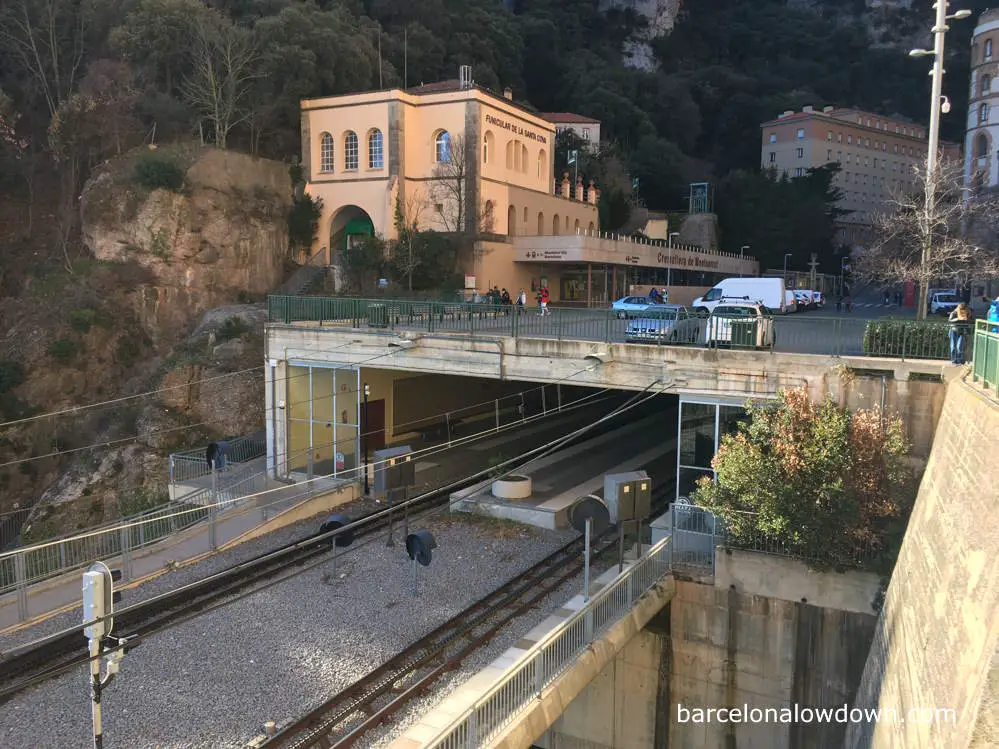
Where to stay at Montserrat
Staying overnight at Montserrat allows you to see the monastery without the crowds of tourists and observe the mountain illuminated by the first rays of sunrise.
For centuries, pilgrims have been staying at the monastery, and today, there are four options for staying at Montserrat:
Hotel Abat Cisneros Montserrat
Hotel Abat Cisneros Montserrat is a three-star hotel located in one of the buildings which make up the monastery complex, right next to the monastery itself. The rooms have been modernised and have all the facilities which you would expect in a modern three-star hotel, plus fantastic views. The hotel also has a good restaurant on the ground floor.
Apartamentos Montserrat Abat Marcet
Apartamentos Montserrat Abat Marcet is an aparthotel with apartments that sleep from one to four people. The apartments are equipped with a microwave, fridge and gas hob. There are a couple of small shops in the monastery complex where you can buy basic foodstuffs, including vegetables, locally made cheese, honey and cured meats.
Alberg Abat Oliba
Alberg Abat Oliba offers hostel-type accommodation in rooms that sleep up to six people. The hostel is located above the La Plaça snack bar and also has dormitory beds with a discount for pilgrims who are walking the Camino de Santiago. You need to have an official pilgrims’ credential in order to claim the discount. To book a bed in the dormitory, call: (+34) 93 877 77 01.
The Montserrat Campsite
Area Esportiva I D’Acampada Montserrat is a small campsite located a ten-minute walk from the monastery, next to the footpath towards the Cross of St Michael. The campsite can only be reached on foot; hence it’s mostly used by climbers and hikers. For around €10 per night, it’s a no-frills campsite with space to put your tent and cook, plus showers and toilets.
The campsite only opens in the summer and doesn’t have a website. According to Google, the telephone number for further information is: (+34) 93 877 77 77.
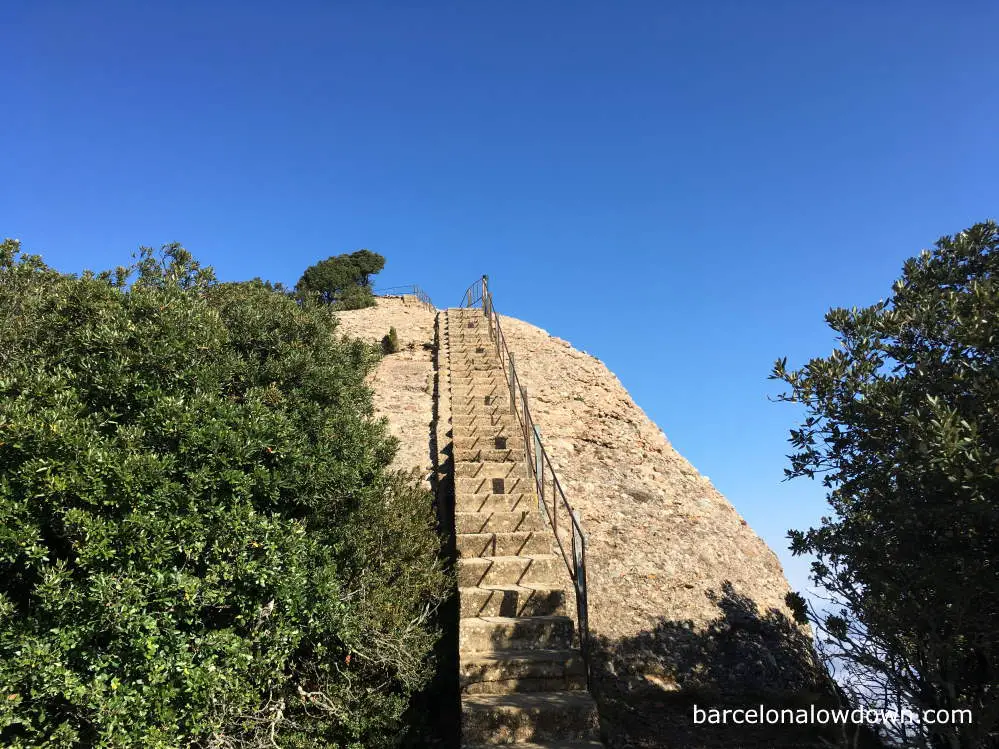
Where to eat at Montserrat
There are several places to eat at Montserrat at different price points. When I visit with friends, we typically have breakfast at the Bar de la Plaça snack bar and then have a picnic lunch up on the mountain.
This year I plan to eat at the restaurants and will update the post with reviews as soon as I can. In the meanwhile, here’s a basic description of where to eat at the Monastery of Montserrat:
Restaurant Abat Cisneros is the restaurant of the hotel Abat Cisneros and serves an a la carte menu of Mediterranean cuisine. The restaurant is located in a building that dates back to the fifteenth century.
Restaurant Montserrat is a large self-service restaurant located in a modern building located near the coach park, with panoramic views of the Santa Cova and the surrounding countryside. The Tot Montserrat ticket includes a meal at this restaurant.
La Cafeteria is also a self-service, cafeteria-style restaurant located in the monastery complex next to the Espai Audiovisual exhibition.
Bar de la Plaça is a small snack bar which serves hot and cold drinks, sandwiches, pastries and other snack food. As I said earlier, we usually have breakfast here, and a cup of coffee with a bocata (the typical Spanish baguette sandwich shown in this post) costs about seven euros.
Recommended Itineraries for visiting Montserrat using public transport
The itineraries below combine culture, scenery and physical activity.
The full-day itinerary is an ideal plan for first-time visitors who want to see and do as much as possible.
The half-day itinerary, on the other hand, aims to pack the essence of Montserrat into the minimum time frame possible.
If you are visiting at the weekend and want to see the Black Madonna up close, then I recommend that you get up early and catch the 7:36 train from Plaça d’Espanya, followed by the rack railway up to the monastery.
There are earlier trains, but they’re not worth catching because the rack railway doesn’t start operating until 8:35 am, so you’d just end up sitting about at Monistrol de Montserrat station.
Half-day Monserrat Itinerary
- Catch the R5 train from Plaça d’Espanya, followed by either the cable car or rack railway up the mountain to the monastery (Time needed: 1.5 hrs).
- Visit the monastery and possibly see the Black Madonna (Time needed: 30 minutes).
- Take the Sant Joan funicular up to the “Pla de les Taràntules“, check out the views from the viewpoint and then either walk back to the monastery via St. Michaels Cross, following this trail on Wikiloc or take the funicular back down (Time needed: 1.5 hours).
- Visit the Espai Visual exhibition and learn about the mountain and the monastery (Time needed: 30 minutes).
- Catch the cable car or rack railway back down the mountain, followed by the R5 train back to Barcelona (Time needed: 1.5 hours)
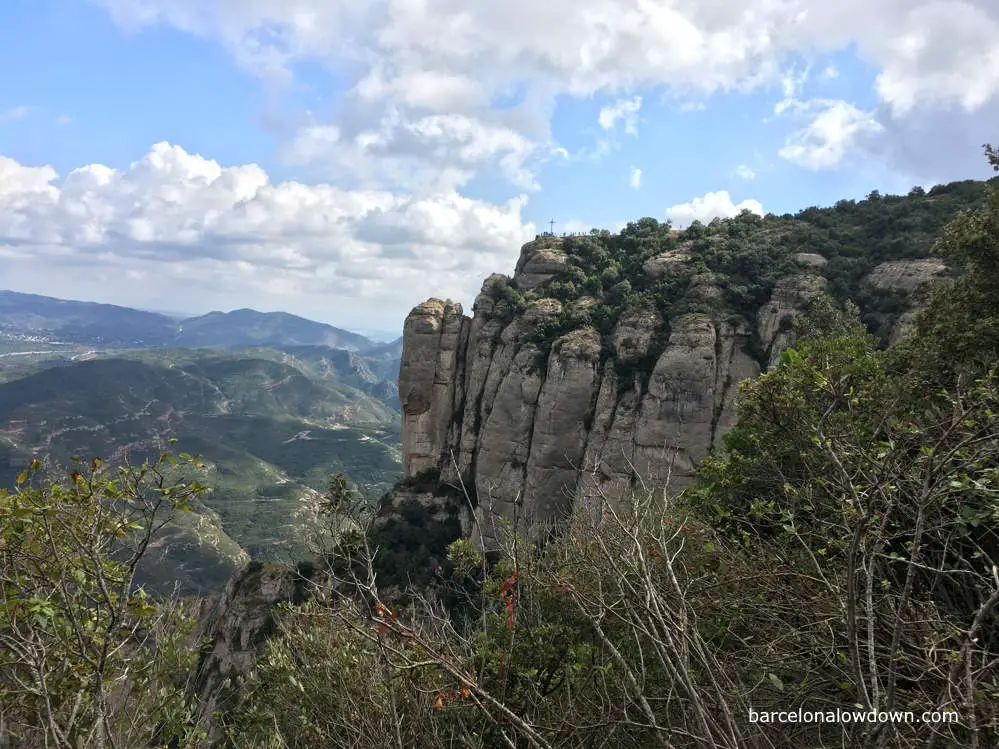
Full-day Montserrat Itinerary
- Catch the R5 train from Plaça d’Espanya, followed by either the cable car or rack railway up the mountain to the monastery (Time needed: 1.5 hrs).
- Visit the Abbey and possibly see the Black Madonna (Time needed: 30 minutes).
- Take the Sant Joan funicular up to the “Pla de les Taràntules”, check out the views from the viewpoint and then walk to the peak of Sant Jeroni, then back down to the monastery via “Pla dels Ocells” following this trail on Wikiloc (Time needed: 3 hours).
- Have lunch at one of the restaurants near the monastery or eat a picnic lunch on the mountainside (Time needed: 1 hour).
- Visit the Espai Visual exhibition and learn about the mountain and the monastery (Time needed: 30 minutes).
- Walk down to the Santa Cova, visit the chapel and then catch the funicular back up to the monastery. (Time needed: 1 to 1.5 hours)
- Check out the Stairway to Heaven monument and the stalls selling local cheese and honey (Time needed: 20 minutes)
- Catch the cable car or rack railway back down the mountain, followed by the R5 train back to Barcelona (Time needed: 1.5 hours)
Weather and what to wear
Montserrat is only thirty-five kilometres from Barcelona, so you would expect the weather to be similar. Although this is generally true, the mountain is 1,265 metres high and is, therefore, much more exposed.
In the summer, temperatures are approximately the same as in Barcelona, but in winter, they tend to be slightly lower, especially at night.
For example, on a sunny winter’s day in Barcelona, temperatures will typically be around sixteen degrees Centigrade at midday and five or six degrees at night. On the same day at Montserrat, you could expect the temperatures to be about the same at mid-day but drop below zero at night.
Another thing to consider is that it tends to be windier at the mountain, making it feel cooler, and it is often misty, especially first thing in the morning.
If you only plan to visit the monastery, then you can pretty much wear the same clothes as you would for visiting a church in Barcelona, although if visiting in winter you should bring a warm jacket.
If you plan to do any hiking, then you should check the weather forecast and dress in layers. Temperatures can vary greatly throughout the day, so you need to be able to adjust accordingly. For example, although you might need a warm jacket first thing in the morning, by midday, you could be in just a T-shirt and shorts.
Typically in winter, I’d wear a wool mix T-shirt as the base layer, a mid-weight thermal jacket as a mid-layer, and then carry a waterproof jacket in case it gets windy or rains.
Don’t worry if you haven’t got specialised outdoor gear; the vast majority of people visiting Montserrat do so in regular clothes. Unless the weather’s bad, a T-shirt plus a jumper or hoodie and a warm jacket will do equally well. If visiting during the summer, then a hat and sunscreen are a must.
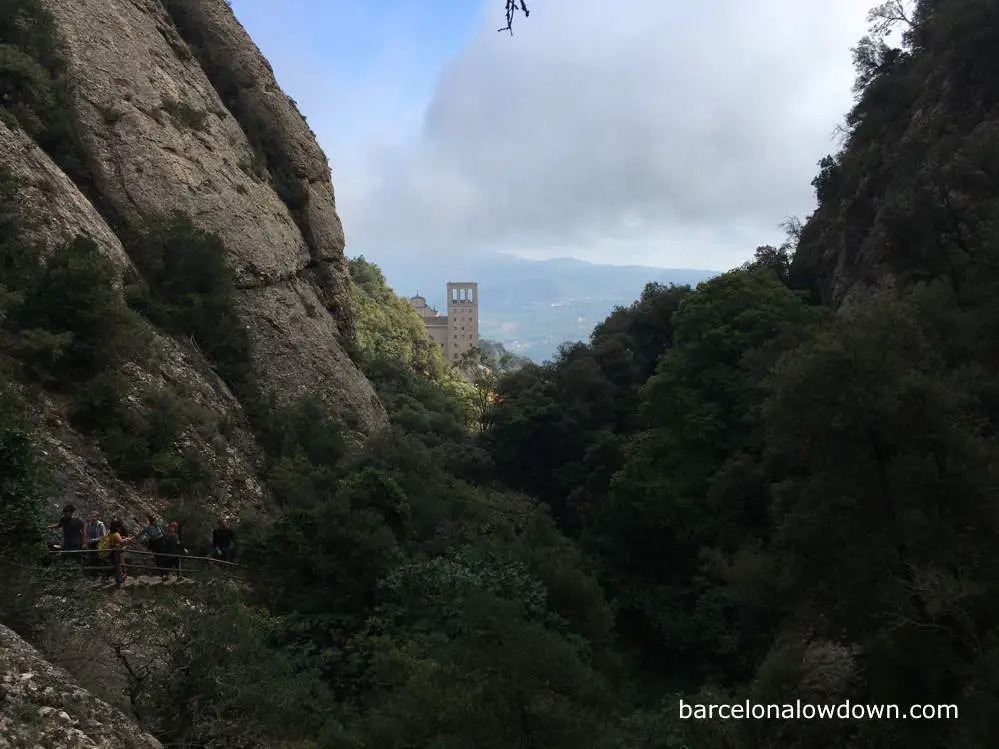
At this point, I’d mention that unless you purely want to visit the monastery and museums, I don’t think it’s worth going to Montserrat if the weather forecast is bad. Personally, I wouldn’t go if it’s forecast to rain or be very cloudy or foggy because you won’t get the views. There are plenty of things to do in Barcelona when the weather’s bad which are far more enjoyable.
Speaking of weather forecasts, I’ve found that Apple’s weather app is pretty reliable. You can also check the forecast on the official Montserrat website. They also have a webcam, although it’s pointed at the Abbey, so isn’t especially helpful.
The footpaths on Montserrat are well maintained, and you don’t need to wear heavy hiking boots. Indeed, many sections of the paths are paved, including the hike up to the peak of St. Jerome.
Trainers or comfortable shoes with decent tread on the soles are fine for all of the walks mentioned in this post. If you are looking for some more specialised shoes, then I can vouch for these walking shoes by Merrell, which are what I use for most of the walks mentioned in this blog.
Dress code for visiting the Basilica de Santa Maria de Montserrat
The dress code for entering the Monastery of Montserrat and the basilica is the same as for most Catholic churches in Spain.
You should dress conservatively and wear a shirt, T-shirt, blouse or jacket which covers your shoulders and mid-riff. Shorts and skirts are allowed, as long as they are long enough to cover your legs to at least mid-thigh. Cropped tops, plunging necklines and transparent fabrics are not permitted. You should also remove your hat or cap before entering the basilica.
Obviously, this only applies when you are actually inside the monastery building. Once outside, you may dress as you please.
Map of Montserrat
Zoom in to see the locations mentioned in this post.
Monestir de Montserrat, Barcelona, España
Monestir de Montserrat, Barcelona, España
Monestir de Montserrat, Barcelona, España
Monestir de Montserrat, Barcelona, España
Monestir de Montserrat, Barcelona, España
Monestir de Montserrat, Barcelona, España
Monestir de Montserrat, Barcelona, España
Monestir de Montserrat, Barcelona, España
Montserrat
Aeri de Montserrat
Monistrol de Montserrat
This post was last updated on April 14th, 2024.


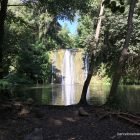
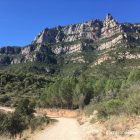
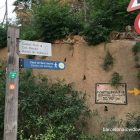
Hi. About buying the Trans Montserrat ticket online. I understand you have to exchange the voucher at the FGC office.
May I know if the FGC office will issue actual train tickets or do you still have to get the actual train tickets at the FGC machine on the day of travel?
I am planning to catch the early 8.30am train from Barcelona to Montserrat and if I can get train tickets the day before, that will be the best, but from what I read, you can’t get train tickets the day before so it seems I still have to queue for tickets on the day of travel.
Thanks for enlightening.
Hi Rita,
I asked my contact at Barcelona Turisme (the official Barcelona tourist office which I link to in the article above) about this last year and she told me the following:
When you purchase the Trans Montserrat online you receive a voucher which you can exchange for the Trans Montserrat pass, which is a cardboard pass with a magnetic strip that you can use at the barriers when boarding the train and show when at the Monastery etc.
The voucher can be exchanged at Barcelona Turisme offices (Plaça de Catalunya or at the airport) or at the office at the FGC train station at Plaça d’Espanya.
She also told me that if you decide to exchange the voucher at the FGC office you have to print it out, whereas at the tourist offices you can show the voucher digitally, ie. on your phone.
I aslo asked whether you could exchange the voucher at the tourist office at the airport when you arrive, and then use the ticket a few days later and she said that was perfectly OK because the pass is activated when you first use it, not when you exchange the voucher.
Thank you. Glad to hear I don’t have to exchange the vouchers for “actual train tickets”.
Thank you the comprehensive guide.
FGC R5 train from Placa d’Espanya to Montserrat – may I know if the train tickets will have assigned seating? Coz I read somewhere that there was a recommendation to take the rack railway on the way down to be able to better secure seats on the train.
Hi Rita,
Thanks for your comment, I’m glad to hear you found the post helpful.
Unfortunately there isn’t assigned seating on FGC trains and you can’t reserve a seat.
As you say, if you’re visiting at the weekend and want to be sure of getting a seat, it’s best to get the rack railway because you board the train at Monistrol de Montserrat, which is the stop before Aeri de Montserrat.
Having said that, I was at Montserrat last weekend and boarded the train at Olesa de Montserrat, which is after Aeri de Montserrat, and there were still free seats.
By the way, even when all the seats are full, you are still allowed to stand in the aisle and I’ve never seen people turned away because the train was full.
Hi,
Thank you so much for the details and updated information.
May I ask for your opinion if my itinery below is feasible and logical? Thank you in advance.
1. Catching first rack railway
2. Visit the Monastery ( the Abbey and black Madonna)
3. Walk to see St Michael’s cross
4. Take Sant Joan funicular to top station
5. Walk the path St. Jerome’s Peak 20 mins and back to station and take funicular to be back to Monastery
6. Visit the Espai Visual exhibition
7. Take Santa Cova funicular, walk to the chapel and back to monastery using funicular
8. check out the viewpoint of stairway to heaven
9. try the honey cheese dessert
10. take cable car to Aeri de Montserrat ( the wait is too long then rack railway instead ) and then train to barcelona.
Hi Lau,
That itinerary is both feasible and logical, although the stated twenty minutes for walking to St. Jerome’s peak is unrealistic.
My only suggestion would be that, instead of visiting St Michael’s cross before taking the St Joan funicular up, you could leave it until later and walk back to the monastery via St Michael’s cross.
What I mean is, you could take the St. Joan funicular up, walk to St Jerome’s peak, walk back to the top station of the St. Joan funicular (as you planned) and then, instead of taking the funicular back down, walk down to the monastery via St. Michael’s cross. If you take a look at this trail, you’ll see what I mean.
The entire walk (top station of the funicular to St. Jerome’s Peak, then back to the monastery via St Michael’s cross will take about two and a half hours.
Another thing which I think is worth mentioning, although you may already know this, is that whe you purchase the passes (Trans Montserrat or Tot Montserrat) you have to choose between either the rack railway or the cable car, you can’t use both with the same ticket. So, if you decide to return by cable car, you’d have to purchase a separate ticket for this.